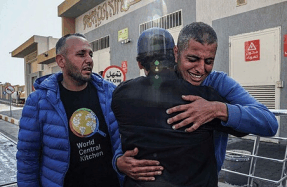THE CHILDREN OF WAR








JULIA MITYAEVA’S SIX-YEAR-OLD daughter Sophia refuses to talk about the things she saw before the family escaped the fighting in Ukraine. Sophia, a vivacious kinder-gartner who likes to dress up in costumes and played a fox in her school ballet recital a couple weeks before Russia invaded her country, won’t let anybody else speak of it in her presence either.
After sharing her family’s harrowing tale of escape with Newsweek during a nearly two hour interview recently, Mityaeva had a few questions of her own for the reporter: When the sounds of the playground are replaced by the thump of artillery shells and explosions hitting nearby, when a child is forced to leave behind everything she knows and loves including a cat named Garfield and a father named Sascha, can she ever truly recover? How much, Mityaeva wanted to know, can a child endure?
“Is Sophia going to be okay?” she asked. “How can you tell if your child is emotionally okay? How can you help your child live a normal life again? How will this experience affect my child in the future?”
Truthful answers to these questions aren’t always what parents want to hear. For children displaced by long, bloody, ongoing conflicts—not just in Ukraine but also in countries like South Sudan, Yemen, Afghanistan and Syria—war often doesn’t end once they have reached safety. A vast body of literature on survivors of war, from as far back as 1944, has established that war is among the worst traumas a child can endure.
The more time children spend in a war zone, the more vulnerable they will likely be to physical diseases and mental health problems later in life. War can also stunt their height, derail education, permanently disrupt earning potential and leave those who make it through with invisible scars that will endure into old age.
Yet in 2020, more than 450 million children worldwide—or 1 in 6—were living in conflict zones, the highest number in 20 years, according to a recent report from the NGO Save the Children. That was before Russia’s 2022 invasion of its neighbor, a nation of 44 million with the second largest country by landmass in Europe. Within weeks, an estimated 15 million Ukrainians, one third of the nation, close to the entire population of the Netherlands, were on the move, the largest displacement of people the continent has seen in more than 75 years. More than 90 percent of these refugees were women and children. The United Nations Children’s Fund (UNICEF) estimates 60 percent of Ukraine’s children have been driven from their homes—two million have fled the country and another 2.5 million are displaced internally.
The Ukraine crisis is providing the most powerful opportunity to date for humanitarian agencies to demonstrate what they
You’re reading a preview, subscribe to read more.
Start your free 30 days





